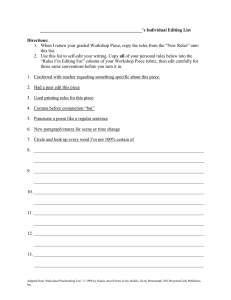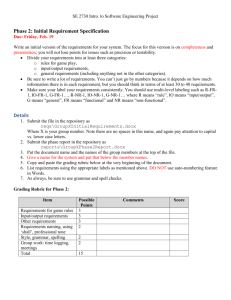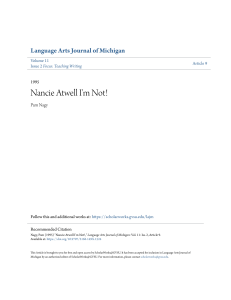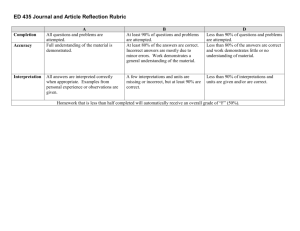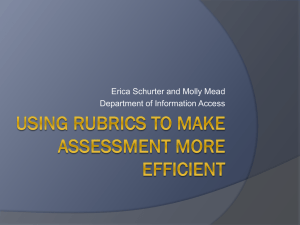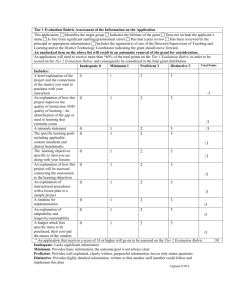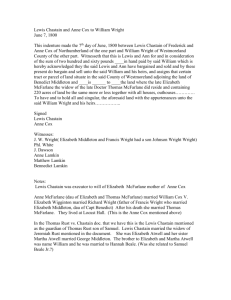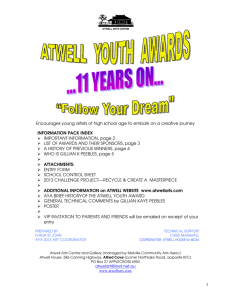Individualizing Instruction Through the Writing Workshop:
advertisement
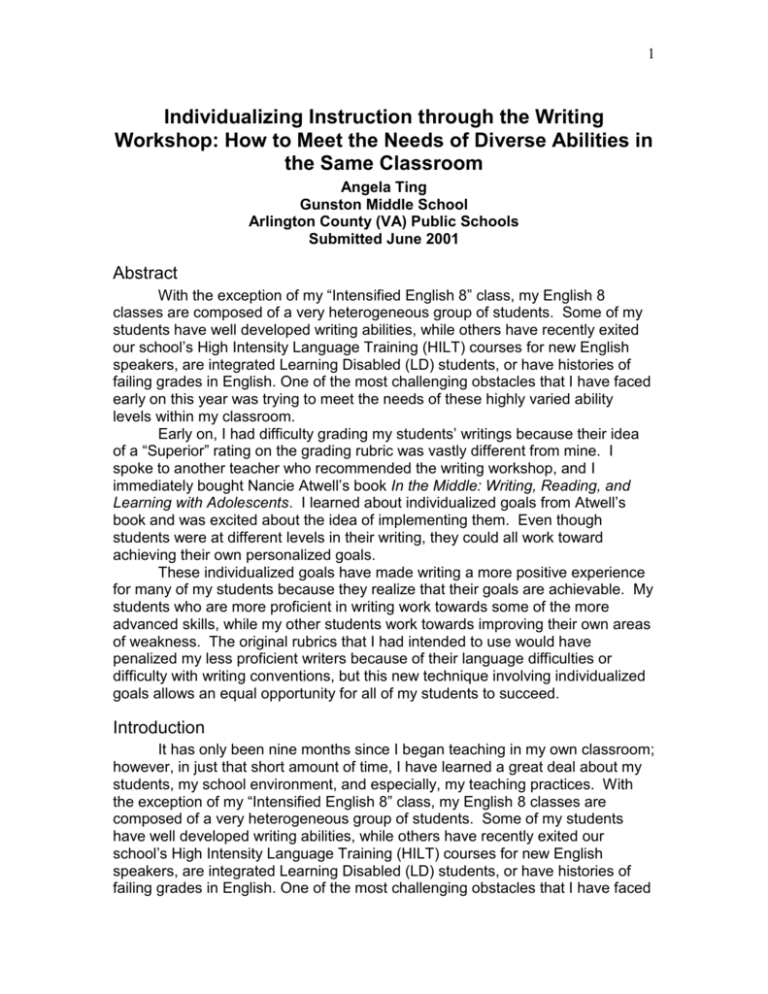
1 Individualizing Instruction through the Writing Workshop: How to Meet the Needs of Diverse Abilities in the Same Classroom Angela Ting Gunston Middle School Arlington County (VA) Public Schools Submitted June 2001 Abstract With the exception of my “Intensified English 8” class, my English 8 classes are composed of a very heterogeneous group of students. Some of my students have well developed writing abilities, while others have recently exited our school’s High Intensity Language Training (HILT) courses for new English speakers, are integrated Learning Disabled (LD) students, or have histories of failing grades in English. One of the most challenging obstacles that I have faced early on this year was trying to meet the needs of these highly varied ability levels within my classroom. Early on, I had difficulty grading my students’ writings because their idea of a “Superior” rating on the grading rubric was vastly different from mine. I spoke to another teacher who recommended the writing workshop, and I immediately bought Nancie Atwell’s book In the Middle: Writing, Reading, and Learning with Adolescents. I learned about individualized goals from Atwell’s book and was excited about the idea of implementing them. Even though students were at different levels in their writing, they could all work toward achieving their own personalized goals. These individualized goals have made writing a more positive experience for many of my students because they realize that their goals are achievable. My students who are more proficient in writing work towards some of the more advanced skills, while my other students work towards improving their own areas of weakness. The original rubrics that I had intended to use would have penalized my less proficient writers because of their language difficulties or difficulty with writing conventions, but this new technique involving individualized goals allows an equal opportunity for all of my students to succeed. Introduction It has only been nine months since I began teaching in my own classroom; however, in just that short amount of time, I have learned a great deal about my students, my school environment, and especially, my teaching practices. With the exception of my “Intensified English 8” class, my English 8 classes are composed of a very heterogeneous group of students. Some of my students have well developed writing abilities, while others have recently exited our school’s High Intensity Language Training (HILT) courses for new English speakers, are integrated Learning Disabled (LD) students, or have histories of failing grades in English. One of the most challenging obstacles that I have faced 2 early on this year was trying to meet the needs of these highly varied ability levels within my classroom. Using a Rubric to Rate Student Papers I was eager to boost my students’ writing fluency and also help boost their achievement early on. So during our second quarter, when I found out about a writing contest in which students created their own newspapers, I went into my classroom and “prepared” my students for the writing task that they were about to engage in. I went over the grading rubric with my students in order for them to know what I was going to grade them on and they claimed that they understood how to achieve a “Superior” rating on the rubric. I soon found out that my students had drastically different ideas of a “Superior” rating than I did. Throughout the week my students worked diligently on their papers. Then it was finally time to collect the first of the four papers that I wanted my students to create. I took them home with me, eager to grade them, and pulled one out of my bag to begin reading over. I thought the grading would be quick. I pulled out a copy of my grading rubric and a highlighter in order to highlight the categories that I thought this paper fell under on this rubric, but when I looked at the paper, my eyes went blank. This wasn’t an essay. All I saw was one long paragraph that took up one side of a page. I began reading, and the thesis was barely identifiable; furthermore, the introduction, body, and conclusion were not even distinguishable. I set that paper aside and decided to look at a paper from my intensified English class. That paper was slightly better, but still my pen could have slashed, dotted, and questioned numerous elements of the paper. During that moment I thought to myself, what was I doing? If I grade my students’ papers according to the rubric then they would surely fail. They had not been properly prepared to attain “Superior” ratings for ideas, organization, voice, word choice, smooth sentences, and conventions. It dawned on me that there were hundreds of elements of my students’ papers that I could mark up. I decided to set the papers aside and grade them at a later time, when I could figure out how to grade them objectively. The rubrics seemed too subjective to use. Seeking Guidance Later that week, I spoke with the other English teacher who teaches in my school and she mentioned that she was using a writing workshop in her classes. She told me about a book called In the Middle: Writing, Reading, and Learning with Adolescents by Nancie Atwell, which I now know is a widely known resource. I immediately went to the library and checked out the book. Within one day, I had read the book, took pages of notes, and was all set to begin the workshop in my class the following week. Atwell’s approach to teaching and grading writing made sense. Instead of using rubrics that covered every possible element of students’ papers, she focused students’ grades on three set goals between the students and herself. 3 Setting Goals Here is a list of possible goals (some are ones that my students and I have created, and others are from Atwell’s new book In the Middle: New Understandings about Writing, Reading, and Learning: Focus your topic and stick to one idea throughout the entire paper. Make each sentence within each paragraph follow the topic sentence. Try new marks to give your writing greater voice, e.g., ; : and -. Put punctuation ( ! or ? or , ) between a quote and its explanatory phrase (never a period). Label and date all papers. Keep all drafts in your work in progress folder. Get homonyms (especially your/you’re, their/there/they’re, and it’s/its) under control. Capitalize only when you intend to. Draft your prose in paragraphs. Use more sensory detail to show and not tell what happens. Organize yourself. Take time at the end of the workshop to straighten your folder and file your drafts. Make a special place in your locker to keep your writing folder. Write 3-4 times a week at home to make deadlines. Avoid slang in formal papers. Eliminate the qualifiers and diminishers that can clutter writing: so, really, very, sort of, kind of. Use apostrophes on contractions to show missing letters: don’t, let’s, that’s, etc. Watch for comma splices. Connect independent clauses with and, start a new sentence, or use a semicolon. Have more peer editors, and have a variety of writers look at your writing. Make more use of direct quotes: bring speaker’s words to life rather than paraphrasing them. Avoid the passive voice. Use active constructions: I. Recognize and keep a consistent verb tense in narratives. Learn the basic conventions governing commas; delete unnecessary commas. Self-edit for spelling by circling, then looking up, every word you’re not absolutely sure of. Setting (Realistic) Goals Of course I’m no Nancie Atwell, but so far, my effort to emulate her practices in my classroom have been very positive. When I looked at this list it seemed very long. I thought about how I might divide it into more manageable chunks and then realized that each student might have a different set of 4 “manageable chunks” they needed to be working on. I decided to use individual writing conference for determining these goals. I began the writing workshop during the second quarter and continued it throughout our third quarter; since then, students have been working towards their own three to four goals that we determined together from their first papers during a writing conference together. Students aim to master their 3-4 goals in each of their papers. Once a student has mastered those goals, he or she is ready for new goals. The use of goals makes it easier for my students to know exactly what they are looking for, and it also makes it easier for me to grade. I simply look to see whether the student has met that goal within the paper. Reflections These individualized goals have made writing a more positive experience for many of my students because they realize that their goals are achievable. My students who are more proficient in writing work towards some of the more advanced skills, while my other students work towards improving their own areas of weakness. The original rubrics that I had intended to use would have penalized my less proficient writers because of their language difficulties or difficulty with writing conventions, but this new technique involving individualized goals allows an equal opportunity for all of my students to succeed. References Atwell, Nancie. (1987). In the Middle: Writing, Reading, and Learning with Adolescents. Portsmouth: Boynton/Cook Publishers. Atwell, Nancie. (1998). In the Middle: New Understandings about Writing, Reading, and Learning, 2nd Edition. Portsmouth: Boynton/Cook Publishers.
